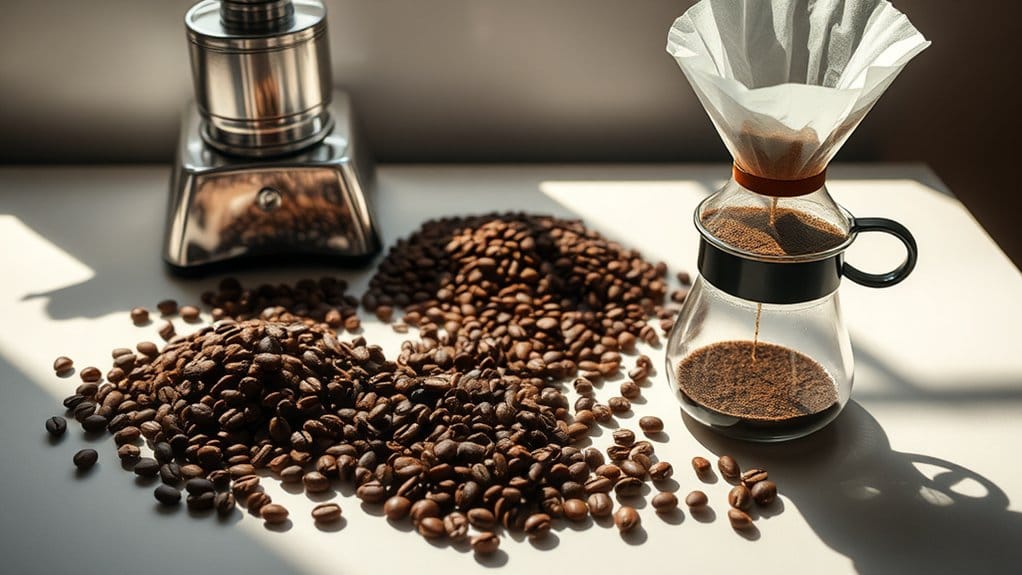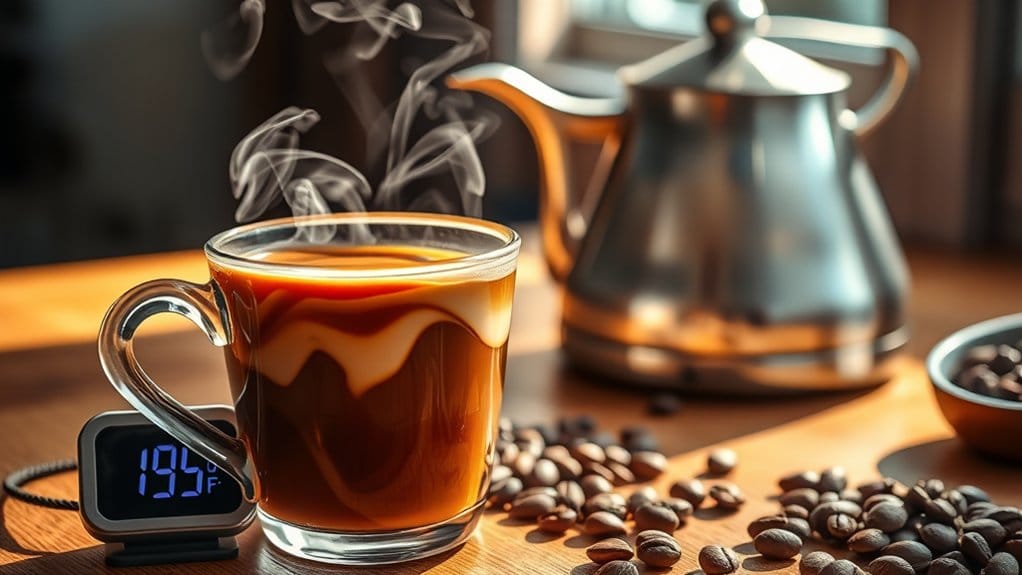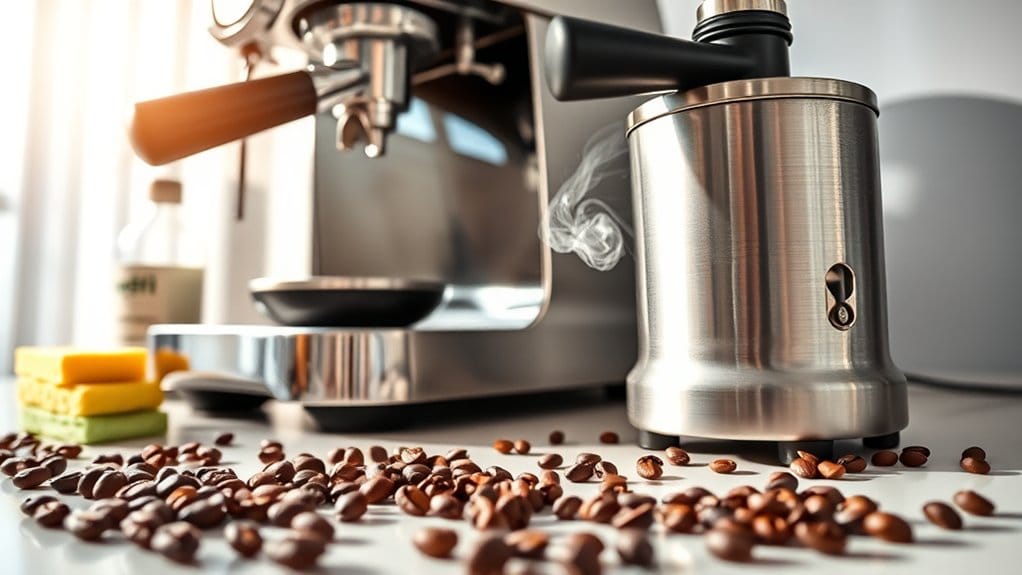Physical Address
304 North Cardinal St.
Dorchester Center, MA 02124
Physical Address
304 North Cardinal St.
Dorchester Center, MA 02124

To brew a fantastic cup of coffee, you’ve gotta nail some extraction basics! Start by adjusting your grind size—finer gives you stronger flavors. Time it right, too; a French press loves 4-6 minutes, whereas pour-over suits 2.5-3 minutes. And don’t forget water temperature; stay between 195°F and 205°F for the best results! Additionally, maintain that 1:15 coffee-to-water ratio for drip coffee. Keep your gear clean, and your coffee will thank you. Want to delve into more tips?

When you start brewing coffee, one of the most important steps is adjusting the grind size for perfect extraction. Think of the grind like magic dust—it can make or break your brew! A finer grind gives more surface area, letting hot water work its flavor magic faster. But be careful! If your brew time runs too long, your cup could taste bitter. On the flip side, a coarse grind leads to a slow extraction that might leave your coffee weak and sour. Each brewing method, from French press to espresso, craves a specific grind size, which directly influences coffee quality and extraction process. In fact, consistent grind size ensures even extraction and flavor enhancement, making your coffee experience even better. Experimenting with grind size variations can lead to discovering unique flavors in your coffee that you might otherwise miss.
Getting the grind size just right is only half the battle in brewing an amazing cup of coffee; the other half is learning to fine-tune your brewing time.
Think of it as a performance—each brew method has its rhythm. For drip coffee, aim for about 4-5 minutes. French press? You need 4-6 minutes for that rich, full-bodied goodness. In pour-over, stick to 2.5-3 minutes for ideal extraction. Brew time manipulation can greatly affect the overall flavor and extraction of your coffee, so don’t hesitate to experiment. Using optimal water temperature is also crucial for achieving that perfect balance of flavor. The ideal water temperature for brewing is between 195°F and 205°F, as recommended for optimal flavor extraction.
Start with recommended times and tweak by 15-30 seconds. Keep everything else constant, like your grind size and dose.
Don’t forget to record your results! Watch how your coffee transforms as you adjust, turning it from sour to fabulous. It’s like finding the perfect song for your morning routine!
Happy brewing!

Despite it might seem like just another detail, choosing the right water temperature can make or break your cup of coffee. Aim for a sweet spot between 195°F and 205°F. Here’s a fun fact: closer to boiling water can actually boost efficiency in extraction. Don’t worry if you don’t have a thermometer—albeit one’s super helpful! Remember, lighter roasts love hotter water, whereas darker ones thrive at lower temps to avoid bitter surprises. Think of it like cooking—too much heat can ruin a good meal! Additionally, understanding that water temperature affects extraction can help you fine-tune your brew. By mastering this temperature rhythm, you’ll unlock flavor profiles that wow your taste buds. Who knew a little heat could lead to such delicious rewards?
Get brewing and enjoy!
Mastering the coffee-to-water ratio is like finding the secret ingredient to a perfect brew. Think of it as the foundation of your coffee adventure!
For drip coffee, aim for about 1:15 to 1:17, or roughly 1-2 tablespoons of coffee for every 6 ounces of water. If you’re feeling brave, try cold brew’s bolder 1:8 ratio.
Using a kitchen scale helps guarantee consistency—no more guessing! Tinker with these ratios to find your sweet spot, balancing strength without diving into the bitter zone. Remember that optimal extraction is influenced by variables like grind size and water temperature, so take your time to experiment!

After you’ve fine-tuned your coffee-to-water ratio, there’s another step to make your espresso experience truly enjoyable: preventing channeling.
Think of your espresso as a cozy jazz tune—you want every note to blend harmoniously.
First, ensure your coffee grounds are distributed evenly. Techniques like the Weiss Distribution Technique (WDT) can help break clumps.
Tap the portafilter gently to settle those grounds, avoiding air pockets that can mess with extraction.
When tamping, apply consistent pressure across the entire puck; uneven tamping‘s like dancing with two left feet!
Finally, measure your coffee dose accurately. Over or underdosing creates instability, leading to channeling. Using a method like the Espresso Machine Method ensures you are applying the right pressure for optimal flavor extraction.
With practice, you’ll brew espresso that hits all the right notes, leaving you smiling!
In the domain of brewing the perfect espresso, fine-tuning the water flow rate can feel a bit like adjusting the volume on your favorite playlist—every little tweak makes a difference.
Most commercial machines work between 250 and 500 grams per 30 seconds, but aiming for that sweet spot of 200 to 280 g/30s really allows the flavors to shine.
Want to measure your flow? Simply engage the pump without the portafilter and weigh the water. It’s that easy!
You can even play around with low flow pre-infusion to saturate your coffee puck.
Additionally, adjusting the grind size can further influence resistance and flavor extraction, making each shot unique.
And, hey, it’s like testing out different music genres—experiment with flow techniques to uncover your own delicious mix!
Enjoy the expedition; you’re brewing art!

When you’re brewing your morning cup, clean equipment plays an important role in consistent results. Imagine sipping coffee that’s bursting with flavor, not tainted by old oils!
To keep your gear in top shape, clean removable parts like the portafilter and drip tray weekly with mild detergent. Don’t forget to scrub filters and shower screens to banish buildup.
Regular descaling’s vital too, especially if you’ve got hard water. It clears mineral deposits, helping flavors shine. And let’s not ignore the grinder; a weekly brush keeps it fresh. In addition, implementing routine maintenance ensures optimal performance and prevents the buildup of residues.
After all, even espresso machines deserve some love! So, make cleaning a habit, and you’ll enjoy those rich, delicious brews every day. Your taste buds will thank you!
Altitude affects coffee extraction by lowering boiling points, resulting in slower extraction. At higher elevations, you need finer grinds and precise water temperature to improve flavors, ensuring a richer cup regardless of altitude challenges.
You can reuse coffee grounds for brewing, but don’t expect great flavor. After the first brew, most oils and compounds are extracted, leaving you with a weak, bitter cup instead of a fresh, rich taste.
For best coffee brewing, use filtered water to remove impurities during keeping beneficial minerals. Aim for balanced mineral content and a neutral pH, ensuring your coffee tastes rich and full. Avoid distilled or overly mineral-heavy water.
Different beans distinctly impact extraction flavor. Arabica offers sweetness and complexity, whereas Robusta enhances bitterness. Light roasts highlight fruity notes, but dark roasts deepen flavors, affecting acidity and overall brewing experience. Pay attention to your choice!
Yes, pre-wetting coffee filters helps eliminate paper taste and maintains temperature stability. It promotes even water flow, reduces channeling, and improves flavor clarity, leading to a more balanced and satisfying cup of coffee.